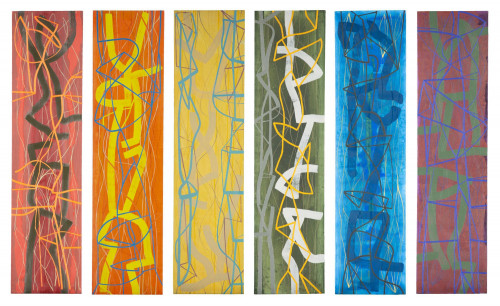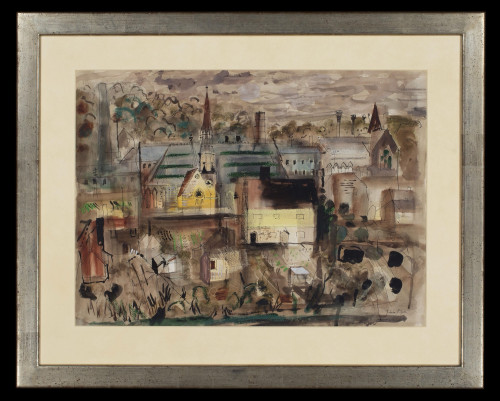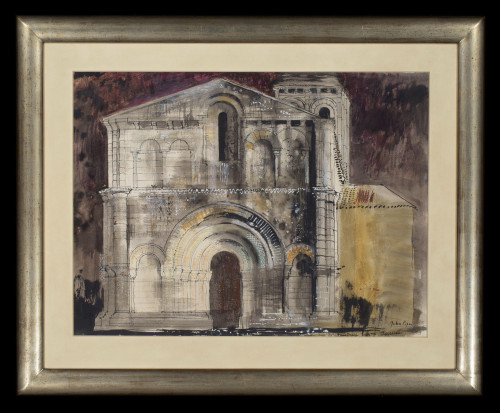Michael Ayrton, White Still Life, 1959, Oil, Board, Matthieson
11300
Michael Ayrton (British, 1921-1975)
White Still Life
Signed and dated 'Michael Ayrton 59' (upper left)
Oil on board
Provenance:With Matthiesen Ltd., London, cat. no. 30
Related To: Black Still Life, 1959, a work of the same composition, size & medium but with a black background and possibly intended to pair White Still Life as an opposition. This work also bears a Mathiesen Ltd label.
Measures: Board height 101. 5 cm . , 3ft . , 4 in., length 76 cm., 2ft, 6 in.,
In a white bevelled frame,
Frame height 113.5 cm., 44 ¾ in. , length 88.5 cm., 35 in
Ayrton wrote: 'To practice an art is primarily to discover one's relationship with reality an attempt to find what in essence is real [and] communicate part of this experience to others and so enlarge their experience.'
The author and collector J C Leissring wrote: 'There is a peculiar mystery about Michael Ayrton that I am unable to unravel from this position in space and time. It may come to pass that at some future time I will encounter just the person who will tell me why Aryton has not achieved the kind of artistic reputation he clearly deserves and why he seems to be hidden in the cracks of art history. This will likely not always be so.' Whilst his handsome features, the powerful torso of the sculptor, and the mellifluous voice of a born teacher and conversationalist were compellingly attractive; Ayrton's relentless curiosity, his considerable eclecticism, and his formidable erudition, backed by a strong physical presence intimidated many people of weaker intellect or personality.
For more than three decades Ayrton practised as a painter, sculptor, draughtsman, engraver, portraitist, stage designer, book illustrator, novelist, short-story writer, essayist, critic, art historian, radio and television broadcaster, and cinema and television film-maker. Ayrton was commercially successful, with constant access to the media, but never achieved lasting critical acclaim. This is not solely due to the post-war placing of abstract above figurative art. Despite his resonant subjects, Ayrton's is a private art, the self-expression of a driven man.
When pressed, Henry Moore, whose judgement Ayrton greatly respected, gave a succinct verdict: 'A fascinating side-alley; not mainstream, but a significant eccentric.
Ayrton's visual work, apart from his portraits, tended to be thematic, with certain ideas and images either obsessively recorded or constantly recurring. In this pairing Ayrton uses the simple imagery of the egg, flowers and skull as metaphors within a stylised composition to explore the cycles of life, birth, life and death. He persues this theme using opposition of colour possibly to explore how perception can change from different vantage points.
In White Still Life Ayrton uses thick application of paint to create a deep, textural, 'sculpted' surface. In contrast to the heavy texture, a subtle palette of whites, greys, pinks and blues presents the imagery in a delicate manner and gives the painting a masterful, yet soft, spiritual quality. The single red flower, stands out, encapusulating the force of life, the drive that Ayrton himself was either loved or disliked for. This work is extremely powerful using simple imagery and subtle colouring juxtaposed with strong, confident, heavy, handling of paint.
The juxtapositon of thickly applied, 'sculpted' texture and a subtle, pale, palette creates a subtle dynamic within this masterful work injecting an inherent spiritual quality which gives Ayrton's intention integrity
Michael Ayrton (British, 1921-1975) is perhaps best known for his large sculptures in metal but he was also committed to painting as well as writing, drawing and printing with a particular interest in etching and lithographs. Of Ayrton's sculptures one of the most famous is Icarus III of which exist three extant casts, one on view at the Smithsonian Space Museum, Washington DC, one outside St. Paul's Cathedral in London, England, and the third in the J.C. Leissring Collection.
Icarus III, Smithsonian Institution Space Museum Washington, D . C
Icarus III, St. Paul's Cathedral London
Minotaur Full Grown Etching 1971
Seated Minotaur with detail Lithograph 1971
Travel to Italy and Greece appears to have had long-lasting effects in Ayrton's imagination as he visited Cumae, where Virgil places Daedalus' landing after his escape from the Labyrinth on Crete. Ayrton was emotionally moved by the legend of Theseus and took the thread of it into himself, somehow becoming, in the process, a kind of latter-day Daedalus, successfully completing in solid materials the stuff of Virgil's story.
White Still Life
The minotaur became a recurrent image in Ayrton's etchings and it is possible that the skull in the White Still Life, with its prominent pair of horns, is that of a minotaur-like creature. In stark contrast with the delicate vase with flowers, the skull is the most salient object in the White Still Life and it succeeds in disturbing the general atmosphere of calm that Ayrton built with his delicate use of white and grey throughout the picture. The presence of an undefined object that is reminiscent of a slightly oversized egg to the left of the vase adds to the mystery behind this still life.
In White Still Life we find another two key interests of Ayrton's, the simple joy of daily life as reflected in a homely interior, and on the other hand, the occult, a fascination shared by many of his contemporaries. This was part of the general fashion of all things Elizabethan that characterised the 1950s when Ayrton also illustrated Webster's Duchess of Malfi and Wilde's The Picture of Dorian Gray.
Mirrors also fascinated Ayrton and, with their infinite variety of and capacity for reflections, dominated his later sculpture where he mixed bronze, polished metal sheet, and perspex to extraordinary effects. The creation of a White and a Black Still Life, produces a mirror effect between the two paintings whose composition is nearly identical and they mirror one another in all aspects except for the variation in colour. It is as if White Still Life could be a reflection or perhaps the negative image of Black Still Life, or vice-versa.
Ayrton fulfilled two major outdoor sculptural commissions in his lifetime, both in the US. Firstly, an outdoor labyrinth for Catskill estate in Arkville New York in 1969 that covered 1,680 feet of passageways and a 9 foot sculpture for the S. S . Kresge headquarters' courtyard at Troy in Michigan USA in 1971.
The Catskill labyrinth
The Catskill labyrinth was a commission from Armand G. Erpf, described by Time Magazine, as 'a contemporary man of myth and a contemporary hero' in the article 'Aesthetics: Knossos in the Catskills' published in August 1969, An investment banker and a multimillionaire at 71, Erpf was regarded as one of Wall Street's most secretive and successful adventurers. In 1965 when he decided that he had to have a maze on his 500-acre property in the Catskills he called Michael Ayrton, a maze-mad English sculptor, architect and author of The Maze Maker, a fictional autobiography of Daedalus. The Erpf maze contains 1,680 feet of passageway, with brick walls running from six to eight feet in height. Ayrton described this work as 'environmental sculpture" whilst Erpf called it 'an aesthetic experience, a symbol in a world so caught up with scientific rationalism it doesn't know where it's going. You can't get to the center of a maze by going straight for it. You have to be indirect. The way to attain something is to go away from it. The maze is a spiritual truth.'
The ambition and imagination exhibited in works such as the Catskill Labyrinth has led a number of art critics to champion Ayrton's oeuvre as they feel that he has remained insufficiently recognised despite his unquestionable achievements. In the US two experts have been particularly committed to championing Ayrton: the Californian collector and writer J.C. Leissring and renowned gallerist Stanley Johnson of the Johnson Gallery in Chicago. Perhaps, as C. P. Snow writes in the introduction to a book by Ayrton about Ayrton's drawings and sculptures (1962):
'We believe in the dumb-ox, the primitive. This is one of the oddest tendencies in advanced Western society and is responsible for both [Ayrton's] lonely position among his contemporaries and for the direction in which his art has gone.'
Nevertheless, Ayrton received a major retrospective shortly after his death when in 1977 the Birmingham Museum and Art Gallery organised an exhibition of his work which subsequently went on tour of the UK . More recently a retrospective at Tate Britain in 1999 has focused on his paintings from the 1940s and 1950s.
J.C. Leissring
J. C. Leissring, a pathologist at Californian Santa Rosa Memorial Hospital for more than 30 years and professor of Medicine at U . C. San Francisco, has been one of Ayrton's most vocal advocates. Leissring started collecting art in 1948 and retired early from medicine in 1970 to found J . C . Leissring Fine Arts which counts with twenty-one works by Ayrton including eight sculptures.
Leissring has often expressed his admiration for the intelligence of concept as well as the depth of Ayrton's work who should be, in his opinion, 'the logical recipient of the baton of sculpture, had he lived, from Henry Moore, the unquestioned fore-runner.'
Leissring first encountered Ayrton's work by Stanley Johnson and this encounter had a long-lasting effect on him: 'My positive reaction to Ayrton required a certain kind of nature, one of genetics and of genetics shaped by experience. I knew it was time to incorporate something mythical into myself when I was introduced to Ayrton by Stanley Johnson of the Johnson Gallery on Michigan avenue in Chicago. In 1969, the magazine, Horizon, presented an essay about Ayrton, describing how he materialized elements of the Theseus myth, the famous story whose main elements include King Minos and his wife, a beautiful white bull, Poseidon, Theseus and his father, Daedalus, Ariadne, Demeter, Kore, the great Labyrinth in Crete and the Minotaur.'
Stanley Johnson of the Johnson Gallery, Chicago - Stanley Johnson, founder in 1955 of the Chicago-based Johnson Gallery, was another strong supporter of Ayrton's work, organising two solo shows in 1972 and 1975, as well as a post-humous 'Homage to Michael Ayrton' exhibition in 1984, all three accompanied by illustrated catalogues. The Johnson Gallery has specialized in museum quality works of art from Dürer and Rembrandt to Degas and Picasso for more than half a century and they have published more than one hundred fifty scholarly catalogues, ranging from Old Master prints and drawings to the art of the nineteenth and twentieth centuries.
Michael Ayrton - Born in 1921 to an avant garde English couple, Barbara Ayrton, socialist politician, and Gerald Gould, poet and literary critic, he was trained as a painter and draftsman. Already from his youth, Ayrton led an independent and unconventional lifestyle which included several early years spent with a cousin in Vienna. When he was 23, he produced a significant book on the subject of British Drawings and in that year gave up a teaching position to take over as art critic as The Spectator. Art critic, illustrator of numerous books, painter, set designer for ballet and theater, prolific contributor to periodicals, writer of numerous books, Ayrton's life was not one destined to be specialized in a fashion acceptable to overseers of British art matters. His work demonstrated sufficient merit to identify him as one of two or three young talents destined to 'shape the future of British art.' according to the notoriously strict critic, Wyndham Lewis (1949).
Ayrton was first associated with the English Neo-Romantic movement, as he was influenced by the style of Pavel Tchelitchew, Henry Moore and Graham Sutherland. He took his mother's maiden name professionally and commenced practising commercial art, sharing a studio with John Minton in Paris in 1939, where they studied with Eugene Berman. He also worked in Chirico's studio and in 1938 went to Les Baux with Minton and Michael Middleton. Ayrton worked with Minton on designing costumes and sets for the 1942 John Gielgud production of Macbeth.
Ayrton's early work, with its elongated figures, sparse landscapes and eerie, star-filled skies, suggests mixed allegiances, with Durer and the Gothic overlaid by French Neo-Romanticism. He acknowledged debts to Tchelitchew and Berman, to Balthus and di Chirico, and 'of course, Picasso', but the relentless need to assert his autonomy also made him desperate to deny them. His notorious 1945 attack on Picasso as 'the Master of Pastiche' can be seen in this light, as can his later obsession with the Minotaur; he needed to re-make (in his own image) the symbol most identified with Picasso and with Cocteau, another early idol.
In the 1940s and 50s Ayrton visited Italy and Greece several times and was much influenced by the Italian Quattrocento. Ayrton began to sculpt in bronze in the early 1950's, receiving advice from Henry Moore and visited Cumae in southern Italy in 1956-57 and Greece in 1958, turning to Greek myth as his principal source of inspiration, particularly the legends of Daedelus and Icarus, the Minotaur and the image of the maze. Ayrton died of a heart attack on 17 November 1975, aged 54, at Hampstead, London.
Provenance: With Matthiesen Ltd., London, cat. no. 30.
20th Century
1959
Other
Collectors
Modern (Of the period)
Commemorative
EXCELLENT
1
1













